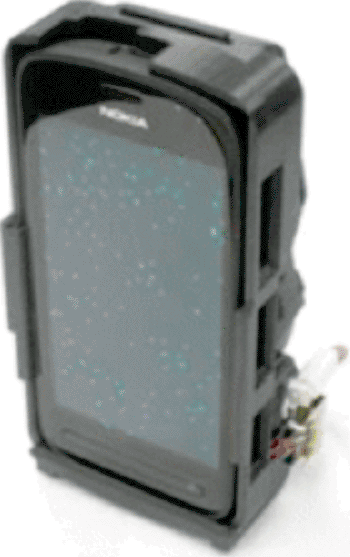Portable Smartphone Microscope Combination Created
By LabMedica International staff writers
Posted on 03 Oct 2013
A novel smartphone microscope adjunct has been created that can detect very small objects including particles that measure approximately 150 nm to 300 nm. Posted on 03 Oct 2013
The portable smartphone attachment can be used to detect viruses and bacteria, eliminating the need for expensive or bulky microscopes and laboratory equipment and only weighs 186 grams.

Image: Screen of the Nokia cell phone showing the fluorescence image of 1 μm diameter green fluorescent beads (Photo courtesy of University of California, Los Angeles).
Bioengineers at the University of California (Los Angeles, CA, USA) attached the device directly to the camera of a smartphone, and described it as a "fluorescent microscope." It was created using a three-dimensional (3D) printer and contains a color filter, an external lens, and a laser diode. The attachment works by illuminating fluid or solid samples at an angle of approximately 75 degrees using the diode. By illuminating the samples at this angle, the scientists say it avoids detecting scattered light that could interfere with the fluorescent image.
This field-portable fluorescent imager on the cell phone involves a compact laser-diode-based excitation at 450 nm that illuminates the sample plane at a high incidence angle, a long-pass (LP) thin-film interference filter, an external low numerical aperture (NA lens), and a coarse mechanical translation stage for focusing and depth adjustment. The 3D optomechanical attachment to the PureView 808 cell phone (Nokia; Espoo, Finland) was designed using Inventor software (Autodesk; San Rafael, CA, USA) and built by a 3D printer (Dimension Elite; Edina, MN, USA).
The device was able to detect single human Cytomegalovirus (HCMV) particles, a virus that can cause birth defects including deafness and brain damage. A single HCMV particle measures approximately 150 nm to 300 nm and the device detected the particles clearly. The device was able to detect nanoparticles, which were marked fluorescent polystyrene beads created especially for the test that measured between 90 nm to100 nm.
The authors concluded that given its high sensitivity and field-portability, the cell-phone-based fluorescence-imaging platform could be useful for specific imaging of various fluorescently labeled specimens such as bacteria and viruses in field settings. Therefore, it holds significant promise for various point-of-care applications such as viral load measurements or other biomedical tests conducted in remote or resource-limited environments. The study was published on September 9, 2013, in the journal ACS Nano.
Related Links:
University of California
Nokia
Autodesk














